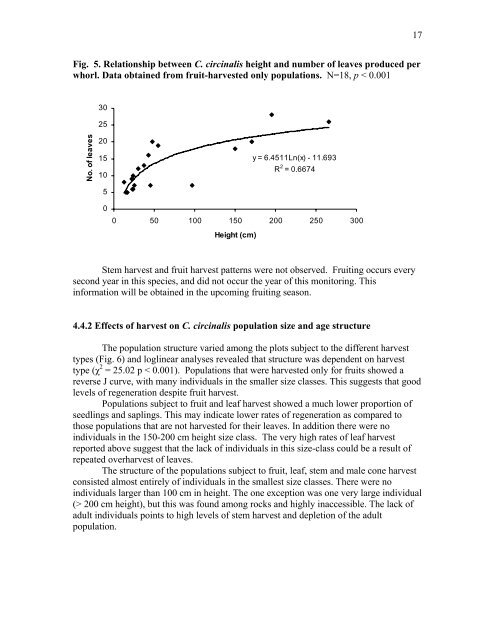Cycas-circinalis-cas.. - Cycad Specialist Group
Cycas-circinalis-cas.. - Cycad Specialist Group Cycas-circinalis-cas.. - Cycad Specialist Group
Fig. 4. Proportion of C. circinalis individuals harvested for their leaves according to size-classes. No. of individuals 18 16 14 12 10 8 6 4 2 0 Seedlings
Fig. 5. Relationship between C. circinalis height and number of leaves produced per whorl. Data obtained from fruit-harvested only populations. N=18, p < 0.001 No. of leaves 30 25 20 15 10 5 0 y = 6.4511Ln(x) - 11.693 R 2 = 0.6674 0 50 100 150 200 250 300 Height (cm) Stem harvest and fruit harvest patterns were not observed. Fruiting occurs every second year in this species, and did not occur the year of this monitoring. This information will be obtained in the upcoming fruiting season. 4.4.2 Effects of harvest on C. circinalis population size and age structure The population structure varied among the plots subject to the different harvest types (Fig. 6) and loglinear analyses revealed that structure was dependent on harvest type (χ 2 = 25.02 p < 0.001). Populations that were harvested only for fruits showed a reverse J curve, with many individuals in the smaller size classes. This suggests that good levels of regeneration despite fruit harvest. Populations subject to fruit and leaf harvest showed a much lower proportion of seedlings and saplings. This may indicate lower rates of regeneration as compared to those populations that are not harvested for their leaves. In addition there were no individuals in the 150-200 cm height size class. The very high rates of leaf harvest reported above suggest that the lack of individuals in this size-class could be a result of repeated overharvest of leaves. The structure of the populations subject to fruit, leaf, stem and male cone harvest consisted almost entirely of individuals in the smallest size classes. There were no individuals larger than 100 cm in height. The one exception was one very large individual (> 200 cm height), but this was found among rocks and highly inaccessible. The lack of adult individuals points to high levels of stem harvest and depletion of the adult population. 17
- Page 1 and 2: Harvest, trade, and conservation of
- Page 3 and 4: 3) Assess the impacts of harvest on
- Page 5 and 6: Fig. 1. Biophysical zones of the Ni
- Page 7 and 8: Fig 2. Location of C. circinalis st
- Page 9 and 10: harvest , ratio of female: male ind
- Page 11 and 12: Table 3 Cont’d. Pith Yes Yes Medi
- Page 13 and 14: Fig. 3. Cycas Circinalis L. a) adul
- Page 15: In total, 150 Cycas circinalis indi
- Page 19 and 20: There was a very strong positive co
- Page 21 and 22: 5. Discussion 5.1 Traditional fruit
- Page 23 and 24: populations would be to push for a
- Page 25 and 26: Nantel, P., Gagnon, D. & Nault, A.
- Page 27: Can you predict productivity and wh
Fig. 5. Relationship between C. <strong>circinalis</strong> height and number of leaves produced per<br />
whorl. Data obtained from fruit-harvested only populations. N=18, p < 0.001<br />
No. of leaves<br />
30<br />
25<br />
20<br />
15<br />
10<br />
5<br />
0<br />
y = 6.4511Ln(x) - 11.693<br />
R 2 = 0.6674<br />
0 50 100 150 200 250 300<br />
Height (cm)<br />
Stem harvest and fruit harvest patterns were not observed. Fruiting occurs every<br />
second year in this species, and did not occur the year of this monitoring. This<br />
information will be obtained in the upcoming fruiting season.<br />
4.4.2 Effects of harvest on C. <strong>circinalis</strong> population size and age structure<br />
The population structure varied among the plots subject to the different harvest<br />
types (Fig. 6) and loglinear analyses revealed that structure was dependent on harvest<br />
type (χ 2 = 25.02 p < 0.001). Populations that were harvested only for fruits showed a<br />
reverse J curve, with many individuals in the smaller size classes. This suggests that good<br />
levels of regeneration despite fruit harvest.<br />
Populations subject to fruit and leaf harvest showed a much lower proportion of<br />
seedlings and saplings. This may indicate lower rates of regeneration as compared to<br />
those populations that are not harvested for their leaves. In addition there were no<br />
individuals in the 150-200 cm height size class. The very high rates of leaf harvest<br />
reported above suggest that the lack of individuals in this size-class could be a result of<br />
repeated overharvest of leaves.<br />
The structure of the populations subject to fruit, leaf, stem and male cone harvest<br />
consisted almost entirely of individuals in the smallest size classes. There were no<br />
individuals larger than 100 cm in height. The one exception was one very large individual<br />
(> 200 cm height), but this was found among rocks and highly inaccessible. The lack of<br />
adult individuals points to high levels of stem harvest and depletion of the adult<br />
population.<br />
17



